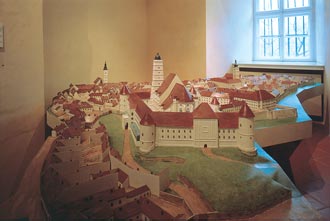Permanent Display 11. Kaptol
 The name KAPTOL derives from the Latin word capitulum - the Chapter of Zagreb, i.e. the canons, who lived around the cathedral. They built their houses (curiae) on the main street and in the square in front of the cathedral. These timbered houses frequently burnt down in great fires, which is why in later centuries houses were built of brick and stone. The building boom that began in the late 17th century continued into the first half of the 18th century. In addition to a number of fine Baroque mansions, the town hall was built in the main square and a special building within the fortifications to house the large library.
The name KAPTOL derives from the Latin word capitulum - the Chapter of Zagreb, i.e. the canons, who lived around the cathedral. They built their houses (curiae) on the main street and in the square in front of the cathedral. These timbered houses frequently burnt down in great fires, which is why in later centuries houses were built of brick and stone. The building boom that began in the late 17th century continued into the first half of the 18th century. In addition to a number of fine Baroque mansions, the town hall was built in the main square and a special building within the fortifications to house the large library.
 On the west side of Kaptol, planned development of a settlement started in the 15th century. Like the two settlements beneath the south wall of Kaptol, it was inhabited by craftsmen, who had workshops and grocer’s shops in their humble houses. Some of the shops were owned by the municipality of Kaptol: in 1788, this was written on the butcher’s shop at 4 Potok and the old pharmacy at 7 Dolac / 7 Opatovina.
On the west side of Kaptol, planned development of a settlement started in the 15th century. Like the two settlements beneath the south wall of Kaptol, it was inhabited by craftsmen, who had workshops and grocer’s shops in their humble houses. Some of the shops were owned by the municipality of Kaptol: in 1788, this was written on the butcher’s shop at 4 Potok and the old pharmacy at 7 Dolac / 7 Opatovina.
The parish church of St. Mary at Dolac was visited by believers from far and wide, especially between 1790 and 1803, when the parish priest was Adam Alojz Baričević, who had an entrance opened for them on the west side of the church. Baričević celebrated Christmas with carol singing in Croatian. His house at Dolac and the rectory bore the name hisa plemenita (‘noble house’).
South Opatovina and Dolac were demolished after 1925 to make room for Zagreb’s main market (1928). The south wall of Kaptol has survived only in the name of Pod Zidom (Under the Wall), the street running parallel to the market.
Željka Kolveshi

